Discover 35 hidden attractions, cool sights, and unusual things to do in Portsmouth (United Kingdom). Don't miss out on these must-see attractions: Spinnaker Tower, Clarence Pier, and HMS Victory. Also, be sure to include Portchester Castle in your itinerary.
Below, you can find the list of the most amazing places you should visit in Portsmouth (England).
Table of Contents
Spinnaker Tower
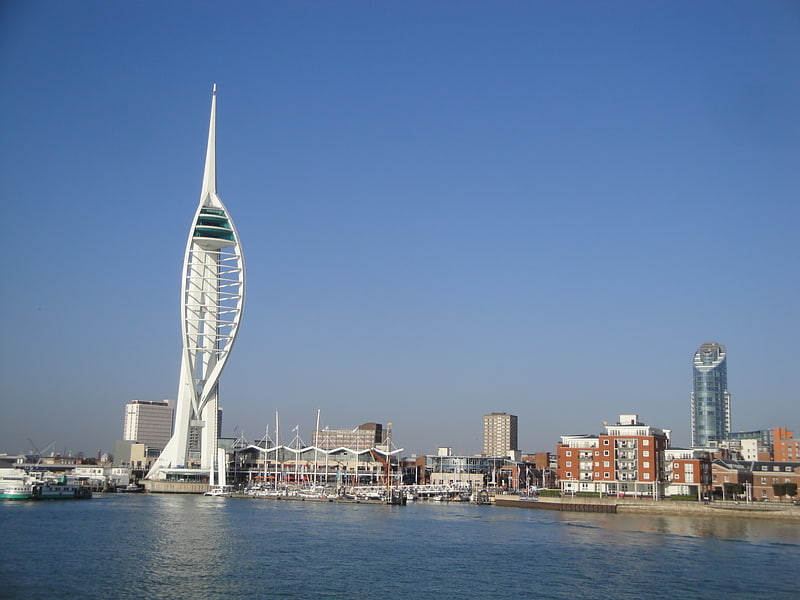
Sail-like tower with panoramic views. The Spinnaker Tower is a 170-metre landmark observation tower in Portsmouth, England. It is the centrepiece of the redevelopment of Portsmouth Harbour, which was supported by a National Lottery grant. The tower's design was chosen by Portsmouth residents from a selection of three different designs in a 1998 public poll. It has three viewing platforms one on top of the other at heights of 100 m, 105 m and 110 m.
The tower was designed by local firm HGP Architects and engineering consultants Scott Wilson and built by Mowlem. The Spinnaker Tower reflects Portsmouth's maritime history through its design and is named after a spinnaker, a type of sail that balloons outward. The tower was opened on 18 October 2005.
The tower is owned by Portsmouth City Council and is operationally managed by Continuum Leading Attractions, a cultural attractions group based in York. Continuum also runs five other visitor attractions across the country.
The Spinnaker Tower was repainted and rebranded as the "Emirates Spinnaker Tower" from July 2015 following a five-year commercial sponsorship deal with Dubai-based Emirates airline. The Emirates sponsorship deal expired in 2020 and the tower reverted to its original all-white paint scheme and name in April 2021.[1]
Address: Gunwharf Quays, PO1 3TT Portsmouth
Clarence Pier

Amusement park in Portsmouth, England. Clarence Pier is an amusement pier in Portsmouth, Hampshire. It is located next to Southsea Hoverport. Unlike most seaside piers in the UK, the pier does not extend very far out to sea and instead goes along the coast.[2]
Address: Clarence Esplanade, PO5 3AA Southsea
HMS Victory

HMS Victory is a 104-gun first-rate ship of the line of the Royal Navy, ordered in 1758, laid down in 1759 and launched in 1765. She is best known for her role as Lord Nelson's flagship at the Battle of Trafalgar on 21 October 1805.
She additionally served as Keppel's flagship at Ushant, Howe's flagship at Cape Spartel and Jervis's flagship at Cape St Vincent. After 1824, she was relegated to the role of harbour ship.
In 1922, she was moved to a dry dock at Portsmouth, England, and preserved as a museum ship. She has been the flagship of the First Sea Lord since October 2012 and is the world's oldest naval ship still in commission, with 244 years' service as of 2022.[3]
Address: Main Rd, PO1 3NU Portsmouth
Portchester Castle
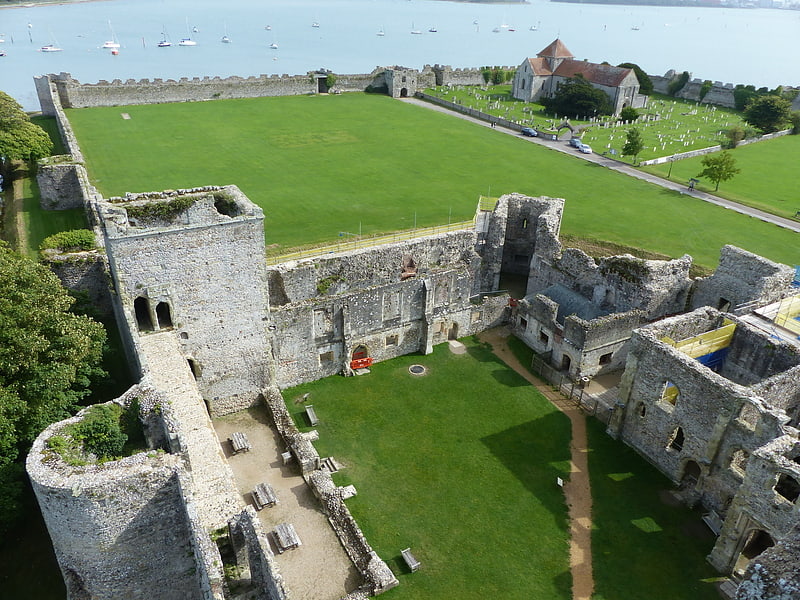
Castle in Portchester, England. Portchester Castle is a medieval fortress that was developed within the walls of the Roman Saxon Shore fort of Portus Adurni at Portchester, to the east of Fareham in Hampshire.
The keep was probably built in the late 11th century as a baronial castle and Portchester was taken under royal control in 1154. The monarchy controlled the castle for several centuries and it was a favoured hunting lodge of King John. It was besieged and captured by the French in 1216 before permanently returning to English control shortly thereafter.
Occupying a commanding position at the head of Portsmouth Harbour, in the medieval period Portchester was an important port. The castle saw the embarkation for several campaigns to France led by England's kings. In anticipation of a French invasion during the first quarter of the 14th century, Edward II spent £1,100 repairing and reinforcing Portchester Castle. A plot to overthrow Henry V was discovered and the culprits apprehended at Portchester; this event features in Shakespeare's play, Henry V. Later in its history, the castle was used as a prison.
Today Portchester Castle is a Scheduled Ancient Monument, and a Grade I listed building. The castle has been in the ownership of the Southwick Estate since the 17th century but is managed by English Heritage and open to visitors throughout the year. The Norman church, St. Mary's, which stands in the south-east corner of the grounds, falls within the Anglican Diocese of Portsmouth.[4]
Address: Church Lane, PO16 9QW Portchester
Southsea Castle

Museum inside 1545 coastal fortress. Southsea Castle, historically also known as Chaderton Castle, South Castle and Portsea Castle, is an artillery fort originally constructed by Henry VIII on Portsea Island, Hampshire, in 1544. It formed part of the King's Device programme to protect against invasion from France and the Holy Roman Empire, and defended the Solent and the eastern approach to Portsmouth. The castle had a square central keep, two rectangular gun platforms to the east and west, and two angled bastions to the front and rear, and was an early English example of the trace italienne-style of fortification popular on the Continent. The Cowdray engraving of the Battle of the Solent in 1545 depicted Henry VIII visiting the castle. Despite several serious fires, it remained in service and saw brief action at the start of the English Civil War in 1642 when it was stormed by Parliamentary forces.
The castle was expanded in the 1680s by Sir Bernard de Gomme and, after a period of neglect in the 18th century, was redesigned again in 1814 during the Napoleonic Wars. After a brief period of use as a military prison in the 1840s, the fortification was expanded in the 1850s and 1860s with additional gun batteries on the east and west sides. The defences were upgraded throughout the century due to the fears of a French invasion and formed part of the plan for defending Portsmouth during the First World War. In the interwar years some of the fortifications were stood down, but the castle saw service again in the Second World War, when it was involved in Operation Grasp, the seizure of French naval vessels in Portsmouth harbour. In 1960, Southsea Castle, by now obsolete, was sold to Portsmouth City Council. It was restored to its pre-1850 appearance and opened as a tourist attraction, receiving over 90,000 visitors from 2011–12.[5]
Address: Clarence Esplanade, PO5 3PA Portsmouth
Gunwharf Quays
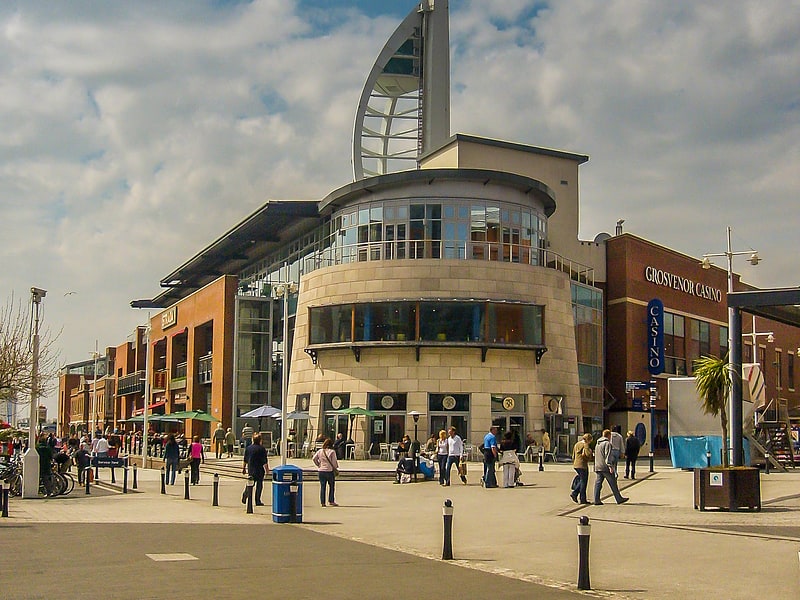
Gunwharf Quays is a shopping centre located in the Portsea area of the city of Portsmouth in England. It was constructed in the early 21st century on the site of what had once been HM Gunwharf, Portsmouth. This was one of several such facilities which were established around Britain and the Empire by the Board of Ordnance, where cannons, ammunition and other armaments were stored, repaired and serviced ready for use on land or at sea. Later known as HMS Vernon, the military site closed in 1995, and opened to the public as Gunwharf Quays on 28 February 2001 after six years of reconstruction. The landmark Spinnaker Tower, which stands close to the site on pilings in Portsmouth Harbour, was opened on 18 October 2005.[6]
Portsmouth Cathedral
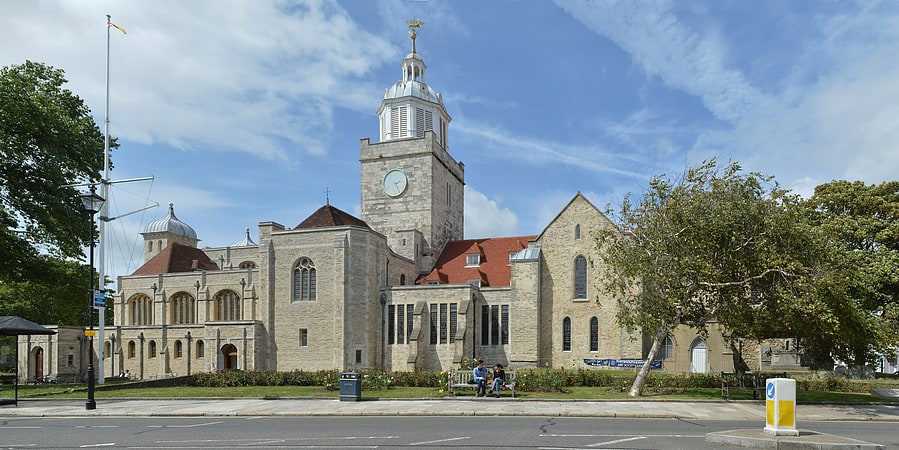
Place of worship since the 12th-century. The Cathedral Church of St Thomas of Canterbury, commonly known as Portsmouth Cathedral, is an Anglican cathedral church in the centre of Old Portsmouth in Portsmouth, England. It is the cathedral of the Diocese of Portsmouth and the seat of the bishop of Portsmouth.
The Anglican cathedral is one of the two cathedral churches in the city, the other being the Roman Catholic Cathedral of St John the Evangelist, Portsmouth, about one mile to the north.[7]
Address: St. Thomas's St, PO1 2HA Old Portsmouth
Portsmouth War Memorial
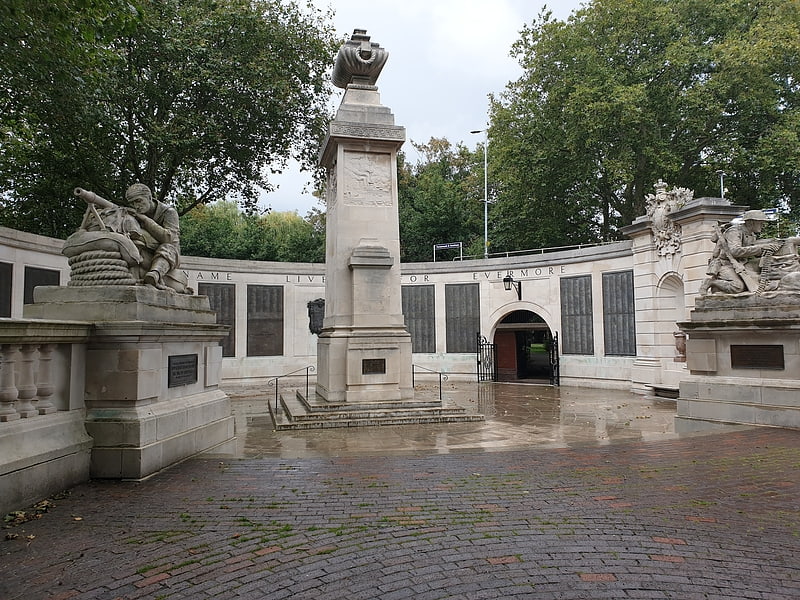
Sculpture by Charles Sargeant Jagger. The City of Portsmouth War Memorial, also referred to as the Guildhall Square War Memorial, is a First World War memorial in Guildhall Square in the centre of Portsmouth, Hampshire, on the south coast of England. Portsmouth was and remains a port and home to a major naval dockyard. The dockyard and the armed forces provided much of the employment in the area in the early 20th century. As such, the town suffered significant losses in the First World War. Planning for a war memorial began shortly after the end of the conflict and a committee was established for the purpose. It selected a site adjacent to a railway embankment close to the Town Hall and chose the architects James Gibson and Walter Gordon, with sculptural elements by Charles Sargeant Jagger, from an open competition.
The memorial consists of a semi-circular sunken recess (exedra) with a screen wall. Bronze panels fixed to the wall list the names of the city's dead. Archways in the wall lead out of Guildhall Square towards Victoria Park and the railway station, and balustrades lead away back into Guildhall Square, terminating in sculptures by Jagger of a life-size soldier and sailor with machine guns. In the centre is a cenotaph surmounted with an urn and decorated on the sides with relief carvings of wartime scenes. Prince Arthur unveiled the memorial on 19 October 1921, before its completion.
Guildhall Square was redeveloped in the 1970s and the memorial was adjusted slightly and another wall was created adjacent to the site. The names of casualties from the Second World War and a monument to that conflict were added in the 21st century. The First World War memorial is a grade II* listed building.[8]
Royal Marines Museum
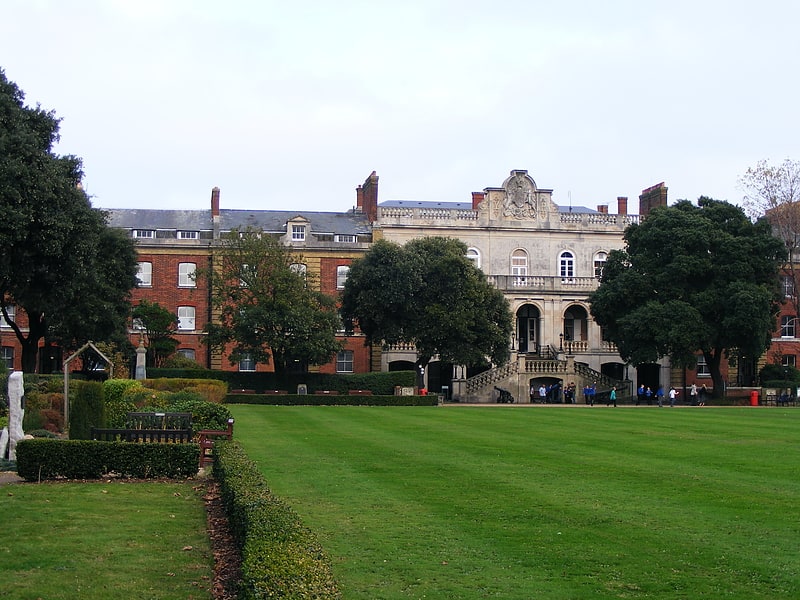
Museum in Portsmouth, England. The Royal Marines Museum is a museum on the history of the Royal Marines from their beginnings in 1664 through to the present day. A registered charity, it is also a designated service museum under the terms of the National Heritage Act 1983 and receives Grant-in-Aid from the Ministry of Defence. During 2011 it formally became part of the National Museum of the Royal Navy, an executive non-departmental public body of the Ministry of Defence. The museum's galleries are currently closed, pending relocation.[9]
Address: Eastney Esplanade, PO4 9PX Portsmouth
Portsmouth Naval Memorial
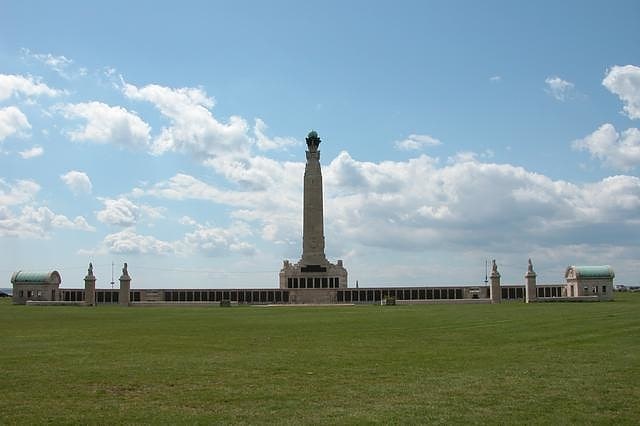
Memorial park in Portsmouth, England. The Portsmouth Naval Memorial, sometimes known as Southsea Naval Memorial, is a war memorial in Portsmouth, Hampshire, England, on Southsea Common beside Clarence Esplanade, between Clarence Pier and Southsea Castle. The memorial commemorates approximately 25,000 British and Commonwealth sailors who were lost in the World Wars, around 10,000 sailors in the First World War and 15,000 in the Second World War. The memorial features a central obelisk, with names of the dead on bronze plaques arranged around the memorial according to the year of death.
To commemorate sailors who had died at sea in the First World War and had no known grave, an Admiralty committee recommended building memorials at the three main naval ports in Great Britain: Chatham, Plymouth, and Portsmouth. Identical memorials at all three sites were designed by Sir Robert Lorimer, with sculpture by Henry Poole.
A separate memorial in Lowestoft commemorates the lost from the Royal Naval Patrol Service; the Fleet Air Arm is commemorated in Lee-on-the-Solent; and merchant seamen are commemorated at the Liverpool Naval Memorial and the Tower Hill Memorial in London. The Royal Naval Division War Memorial is on Horseguards Parade in London.
The memorial is made of Portland stone, with a prominent central obelisk topped by a metal finial. Steps lead up to a plinth bearing bronze inscription plaques fixed to the obelisk's base bearing the names of the lost. Each corner projects as a buttress, surmounted by a statue of a reclining lion, beneath a stepped base to the obelisk. The four-sided obelisk tapers slightly to a stepped top with an elaborate finial with corner ships prows and bronze supports to a verdigris copper ball. The memorial was unveiled on 15 October 1924 by Albert, Duke of York (later King George VI).
The memorial was extended after the Second World War, to a design by Sir Edward Maufe. Names of those lost in the Second World War are recorded on panels set into the low walls of an enclosure added to the north, leading to a barrel-vaulted pavilion on each side. Additional sculpture was created by Charles Wheeler, William McMillan, and Esmond Burton. The additions were unveiled by the Queen Elizabeth, the Queen Mother, on 29 April 1953.
The memorial is maintained by the Commonwealth War Graves Commission. It became a listed building in 1972, and was upgraded to Grade I in May 2016 for the centenary of the Battle of Jutland.[10]
Address: Clarence Esplanade, Portsmouth
Fort Nelson

Building in Portchester, England. Fort Nelson, in the civil parish of Boarhunt in the English county of Hampshire, is one of five defensive forts built on the summit of Portsdown Hill in the 1860s, overlooking the important naval base of Portsmouth. It is now part of the Royal Armouries, housing their collection of artillery, and a Grade I Listed Building.[11]
Address: Portsdown Hill Rd, PO17 6AN Fareham
Royal Garrison Church

Almshouse in Portsmouth, England. Domus Dei was an almshouse and hospice at Old Portsmouth, Hampshire, United Kingdom. It is now also known as the Royal Garrison Church and is an English Heritage property and a Grade II listed building.[12]
Address: Penny Street, PO1 2NJ Portsmouth
Portsmouth Historic Dockyard
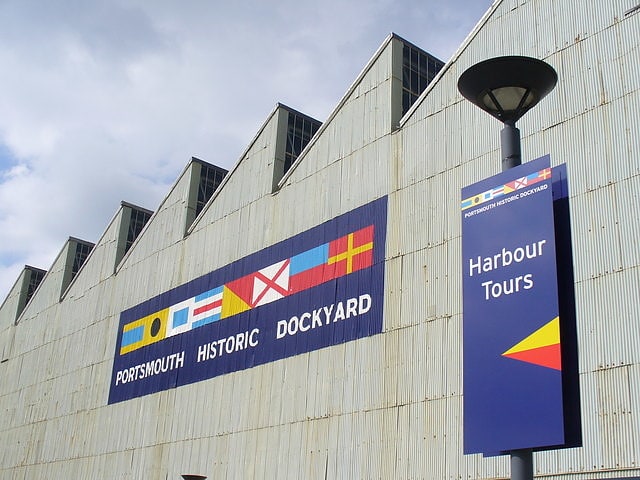
Museum in Portsmouth, England. Portsmouth Historic Dockyard is an area of HM Naval Base Portsmouth which is open to the public; it contains several historic buildings and ships. It is managed by the National Museum of the Royal Navy as an umbrella organization representing five charities: the Portsmouth Naval Base Property Trust, the National Museum of the Royal Navy, Portsmouth, the Mary Rose Trust, the Warrior Preservation Trust Ltd and the HMS Victory Preservation Company. Portsmouth Historic Dockyard Ltd was created to promote and manage the tourism element of the Royal Navy Dockyard, with the relevant trusts maintaining and interpreting their own attractions. It also promotes other nearby navy-related tourist attractions.[13]
Address: Visitor Centre, Victory Gate, PO1 3LJ Portsmouth
D-Day Museum
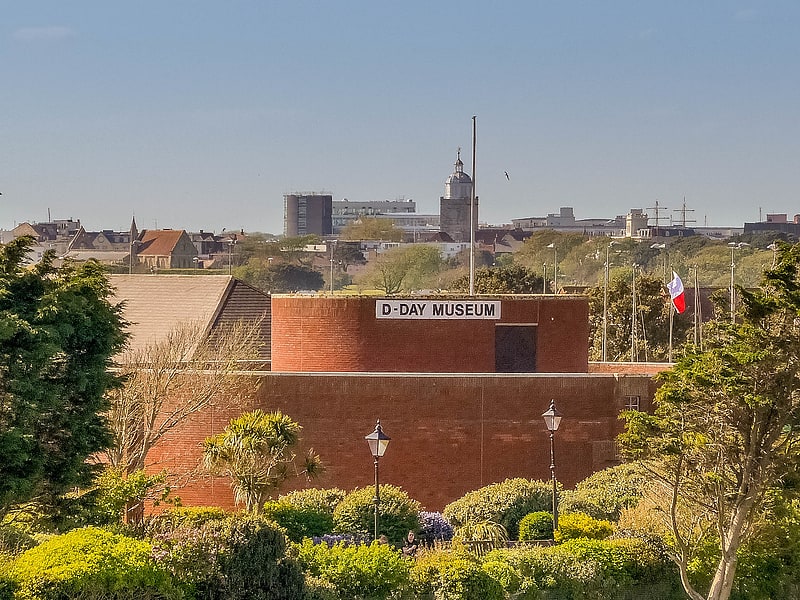
Museum in Portsmouth, England. The D-Day Story is a visitor attraction located in Southsea, Portsmouth in Hampshire, England. It tells the story of Operation Overlord during the Normandy D-Day landings. Originally opened as the D-Day Museum in 1984 by Queen Elizabeth The Queen Mother, it reopened as the D-Day Story, following a refurbishment funded by a £5 million Heritage Lottery grant, in March 2018. The museum building was designed by the then city architect Ken Norrish.[14]
Address: Clarence Esplanade, PO5 3NT Portsmouth
Round Tower

Landmark in Portsmouth, England. The Round Tower is a fortification at the entrance to Portsmouth harbour. It is a Grade I listed building.[15]
Address: Broad Street., PO1 2JE Portsmouth
Fratton Park

Stadium in Portsmouth, England. Fratton Park is a football ground in Portsmouth, England, which is the home of Portsmouth F.C. Fratton Park was first opened on a public open day on Tuesday 15 August 1899. Fratton Park has remained as the only home football ground in Portsmouth FC's entire history.
The early Fratton Park was designed by local architect Arthur Cogswell and built in 1899 on the site of a market garden in Milton, a Portsea Island farming village. In 1904, the village of Milton became a residential suburb of Portsmouth when Portsmouth's boundaries were expanded to include all of Portsea Island. Fratton Park's Portsea Island location means it is uniquely the only football ground in English professional football which is not on the mainland of Great Britain.
The first ever match at Fratton Park took place on the afternoon of Wednesday 6 September 1899, a 2-0 friendly win against Southampton FC, attended by 4,141 supporters. The first ever competitive home match at Fratton Park was played on Saturday 9 September 1899, a Southern League First Division 2-0 win against Reading F.C. attended by 9,000 supporters.
Portsmouth's Milton-based football ground was deceptively named as "Fratton Park" by the club's founders, to persuade supporters that the new football ground was within walking distance of neighbouring Fratton's railway station; the true distance between the railway station and football ground is actually one mile, or a ten minute walk.
Sir John Brickwood (1852–1932) was Portsmouth's founding chairman. Brickwood, a philanthropist, was also owner of a Portsmouth-based brewery. In 1900, the Brickwood Brewery opened a mock-Tudor public house named The Pompey in Frogmore Road next to Fratton Park. In 1905, a mock-Tudor club pavilion, donated by Sir John Brickwood was built in Frogmore Road, immediately to the north of The Pompey pub, which originally contained club offices and players changing rooms. The club's Frogmore Road pavilion and The Pompey pub were both designed by Fratton Park's original architect, Arthur Cogswell.
Fratton Park's maximum capacity reached 58,000 in 1935 after the North Stand and North Terrace were rebuilt. The highest attendance was 51,385, on 26 February 1949 in an FA Cup Sixth Round match vs Derby County. Since the introduction of all-seated stadia policy in 1996, Fratton Park's capacity has been reduced.
On 26 July 1948, Fratton Park hosted a Netherlands vs Ireland first-round football game in the 1948 London Olympics, one of only two grounds outside London to host matches in the Olympic football tournament. The game at Fratton Park was attended by a crowd of 8,000, with a 3–1 win to the Netherlands.
On 22 February 1956, Fratton Park became the first English football ground to stage an evening Football League match under artificial light, against Newcastle United. The original floodlights, positioned at opposite ends on top of Fratton Park's South Stand and North Stand roofs, were replaced in 1962 by floodlight tower pylons in the four corners of the ground.
Fratton Park was used as part of the 70-day long London 2012 Olympic Torch Relay route. The Day 59 relay route began on 16 July 2012, with Portsmouth F.C. steward and D-Day veteran John Jenkins as runner number 001, carrying the Olympic flame onto Fratton Park pitch. The Day 59 torch relay route then set off from Fratton Park, through Portsmouth and eastwards to Brighton & Hove.
Fratton Park's four corner floodlight towers could be widely seen for miles around and became well known in Portsmouth - and also as a useful landmark for visiting away supporters. However, since 2015, the four towers have gradually been replaced by modern roof-level lights. One floodlight tower - from the north-west corner - was renovated and relocated to Fratton Park's main car park on 15 July 2019 for preservation, albeit without its lighting lamps which were not required and removed. The preserved floodlight tower now also acts as a telecommunications antenna tower.
Fratton Park is affectionately nicknamed "The Old Girl" by Portsmouth supporters, and has a reputation for high attendances and a powerful atmosphere, similar to that of larger capacity stadia.[16]
Address: Portsmouth, Frogmore Road, Milton, Portsmouth, Hampshire. PO4 8RA
Chichester Harbour

Chichester Harbour is a 3,733.5-hectare biological and geological Site of Special Scientific Interest west of Chichester in Hampshire and West Sussex. The SSSI is part of Chichester Harbour Area of Outstanding Natural Beauty and Solent Maritime Special Area of Conservation. It is also part of Chichester and Langstone Harbours Ramsar site, Special Protection Area and Nature Conservation Review site, Grade I. Part of it is a Geological Conservation Review site and two areas are Local Nature Reserves.[17]
New Theatre Royal
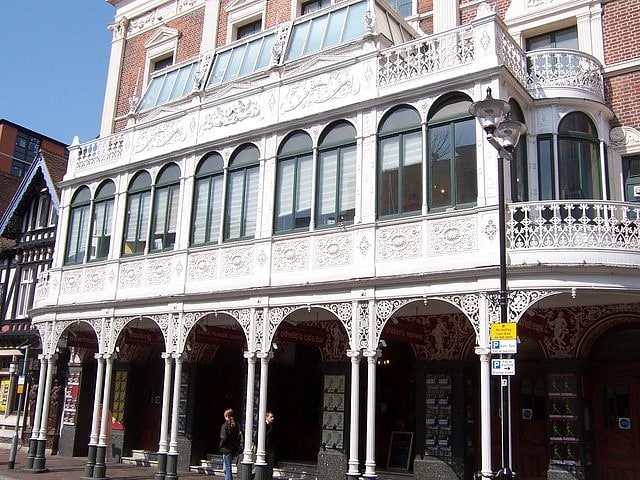
Theatre in Portsmouth, England. The New Theatre Royal is a Victorian Grade II* listed theatre in the heart of Portsmouth, England, with a capacity of 667. The theatre building was constructed in 1854 as Landport Hall. It was converted to a theatre two years later. It was rebuilt in 1884 by Charles J. Phipps and again in 1900 by Frank Matcham.
The Theatre reopened in October 2015 after a £4.7M refurbishment project.[18]
Address: Portsmouth, 20–24 Guildhall Walk
Square Tower
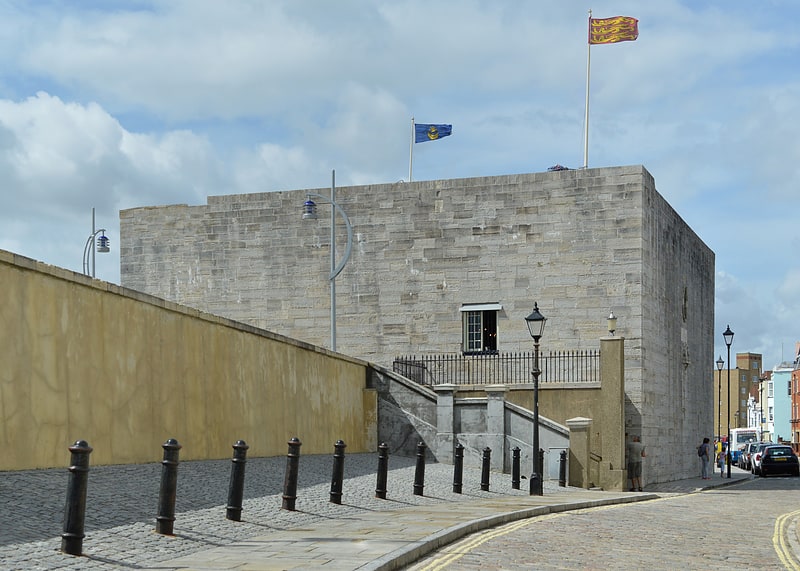
Building in Portsmouth, England. The Square Tower is one of the oldest parts of the fortifications of Portsmouth, England. It is a Grade I listed building.[19]
Address: Broad St, Portsmouth
Portsmouth Guildhall
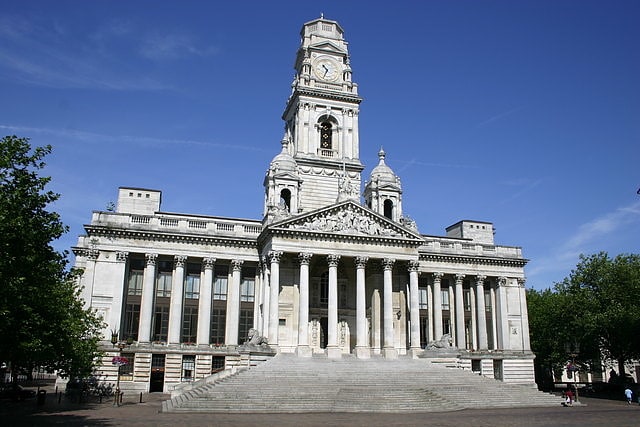
Concert hall in Portsmouth, England. Portsmouth Guildhall is a multi-use building in the centre of Portsmouth, UK, located on a pedestrian square close to the Portsmouth and Southsea railway station. Constructed in 1890, the building was known as Portsmouth Town Hall until 1926. It was heavily damaged by bombing during the Second World War and largely rebuilt during the 1950s by the English architect Ernest Berry Webber. It now operates as a concert, wedding and conference venue. It is a Grade II listed building.[20]
Address: Guildhall Walk, PO1 2AB Portsmouth
Eastney Beam Engine House
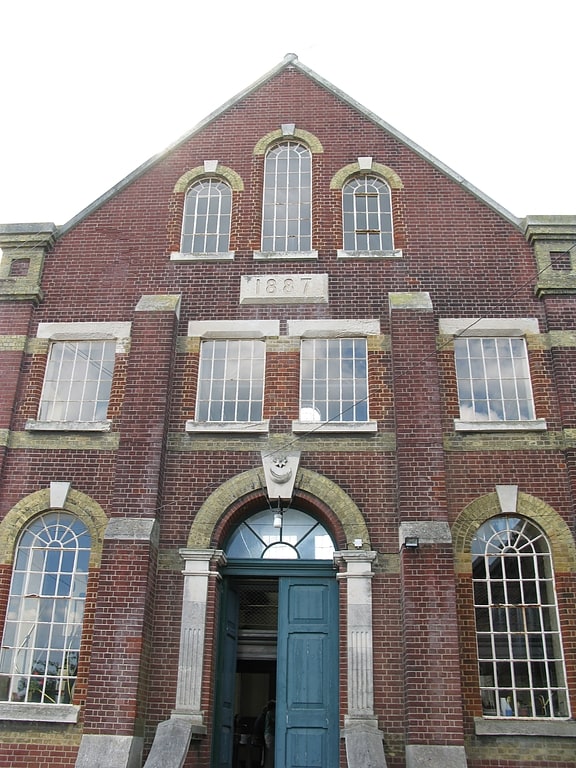
Museum in Portsmouth, England. Eastney Beam Engine House is a Grade II -listed Victorian engine house in Portsmouth, Hampshire, England. Dating from 1887, it contains two 150 hp James Watt & Co. beam engines. The pumps were built as part of a plan to improve Portsmouth's sewage system. The other element of the plan was large holding tanks which held the sewage until the pumps could empty them into the ebb tide. The pumps have since been superseded by advancing technology but have been restored. The restoration was funded by grants totalling £10,066 from Portsmouth city council, £4000 from Hampshire county council and £2000 from the Department of the Environment. The Engine House is now open to the public as a museum, owned by Portsmouth City Council but operated by volunteers; consequently is only open on the last weekend in every month.[21]
Address: Henderson Road, Portsmouth
Port Solent
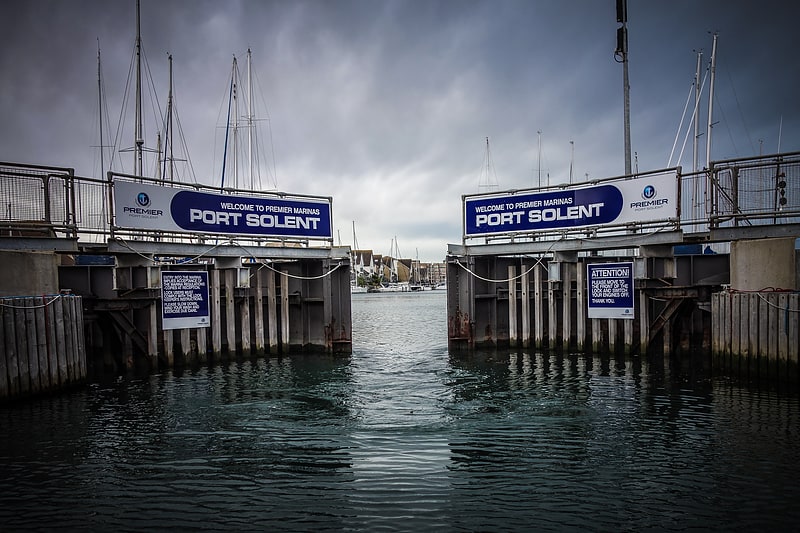
Suburb in Portsmouth, England. Port Solent is the commercial name of a housing and leisure development located in the Paulsgrove suburb of the English city of Portsmouth, Hampshire, comprising a marina, a housing estate, shopping and leisure facilities.
The Port Solent development was built during the late 1980s on reclaimed land taken from the east side of Paulsgrove Lake in Portsmouth Harbour, specifically between the north of Horsea Island and the shoreline of Paulsgrove Quay in Paulsgrove.
Facilities for residents and visitors include a multiscreen cinema, health club, and restaurants and shops along a precinct known as The Boardwalk. The marina is owned and managed by Premier Marinas.
Port Solent was officially opened on 29 July 1988 by H.R.H. Anne, The Princess Royal, who unveiled a commemorative plaque.
Port Solent is politically within the Paulsgrove electoral ward and the Portsmouth North UK Parliament constituency.
The main entrance road junction into the Port Solent development is built almost exactly over the site of the former Paulsgrove Quay shoreline.[22]
Charles Dickens Birthplace Museum
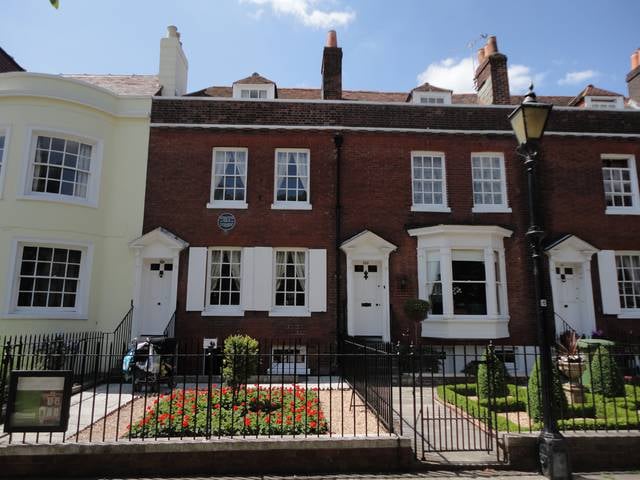
Museum in Portsmouth, England. Charles Dickens' Birthplace Museum is a writer's house museum in Landport, Portsmouth, England situated at the birthplace of the eminent English author Charles Dickens; and as such played a prominent part in the 2012 bicentennial celebrations. It is one of six museums run by Portsmouth Museums, part of Portsmouth City Council.[23]
Address: 393 Old Commercial Rd, PO1 4QL Portsmouth
Kings Theatre
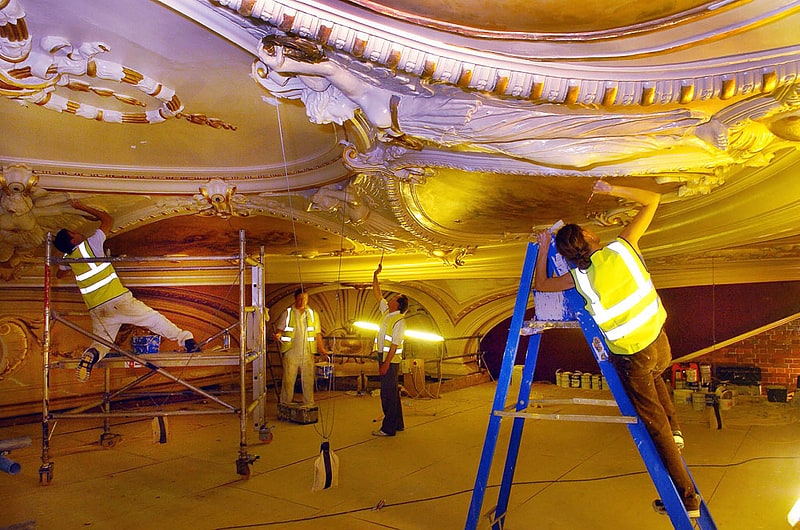
Theatre in Portsmouth, England. The Kings Theatre is a theatre in Southsea, Portsmouth, designed by the architect Frank Matcham. It opened on 30 September 1907. It is operated by the Kings Theatre Trust Ltd. The building was designated a Grade II* listed building in 1976.[24]
Address: Portsmouth, Albert Road
Cathedral of St John the Evangelist
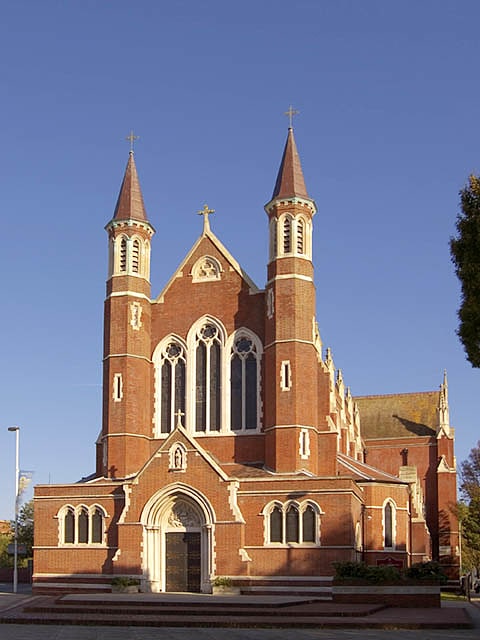
Brick-built Victorian Gothic church. The Cathedral Church of St John the Evangelist is a Roman Catholic cathedral in Portsmouth, England. It is the mother church of the Portsmouth diocese and seat of the Bishop of Portsmouth, currently the Right Reverend Philip Egan. It was dedicated on 10 August 1882.
The cathedral is one of two cathedral churches in the city, the other being the Church of England Cathedral Church of St Thomas which is located about one mile to the south.[25]
Address: Bishop Crispian Way, PO1 3HQ Portsmouth
Lumps Fort
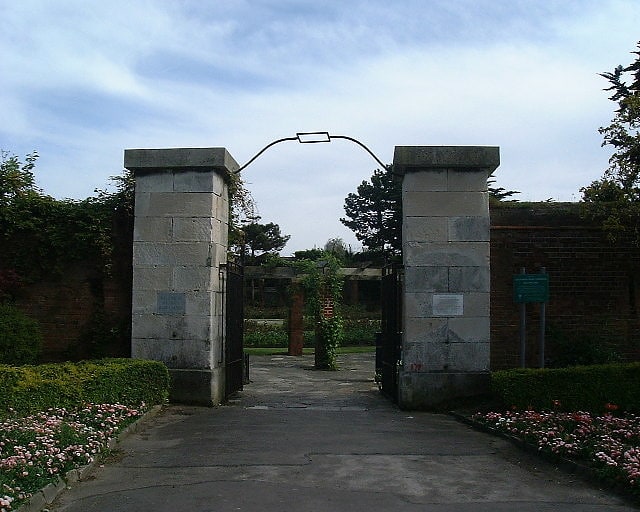
Historical landmark in Portsmouth, England. Lumps Fort is a disused fortification built on Portsea Island as part of the defences for the naval base at Portsmouth.[26]
Address: Eastney Esplanade, PO4 9RU Portsmouth
St Mary's Church

Building in Portsmouth, England. St Mary's Church is the main Church of England parish church for the areas of Portsea and Fratton, both located in the city of Portsmouth, Hampshire. Standing on the oldest church site on Portsea Island, the present building, amongst the largest parish churches in the country, has been described as the "finest Victorian building in Hampshire". It is at least the third church on the site and has been designated a Grade II* listed building by Historic England. Former regular worshippers here have included Charles Dickens, Isambard Kingdom Brunel, and Cosmo Lang.[27]
Address: Fratton Rd, PO1 5PA Portsmouth
Royal Navy Submarine Museum
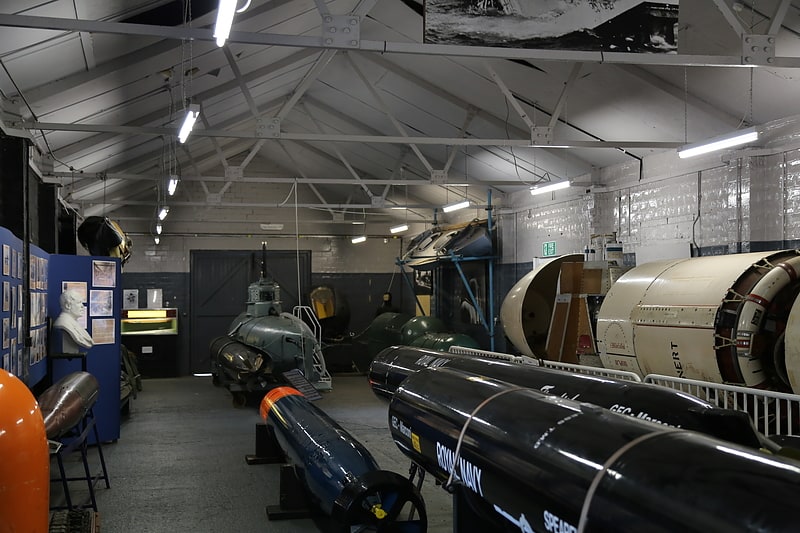
Museum in Gosport, England. The Royal Navy Submarine Museum at Gosport is a maritime museum tracing the international history of submarine development from the age of Alexander the Great to the present day, and particularly the history of the Royal Navy Submarine Service from the navy's first submarine, Holland 1, to the nuclear-powered Vanguard-class submarines. The museum is located close to the former shore establishment HMS Dolphin, the home of the Royal Navy Submarine Service from 1904 until 1999.[28]
Address: Haslar Jetty Road, PO12 2AS Gosport
Fort Brockhurst
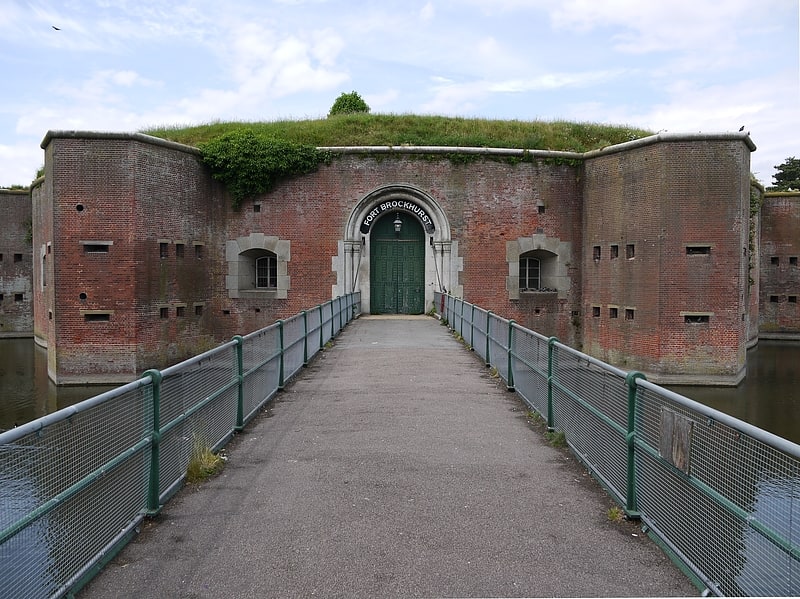
Historical place in Gosport, England. Fort Brockhurst is one of the Palmerston Forts, in Gosport, England and a Scheduled Ancient Monument. It is now an English Heritage property.[29]
Address: Gunners Way, PO12 4DS Hampshire
Fort Gilkicker
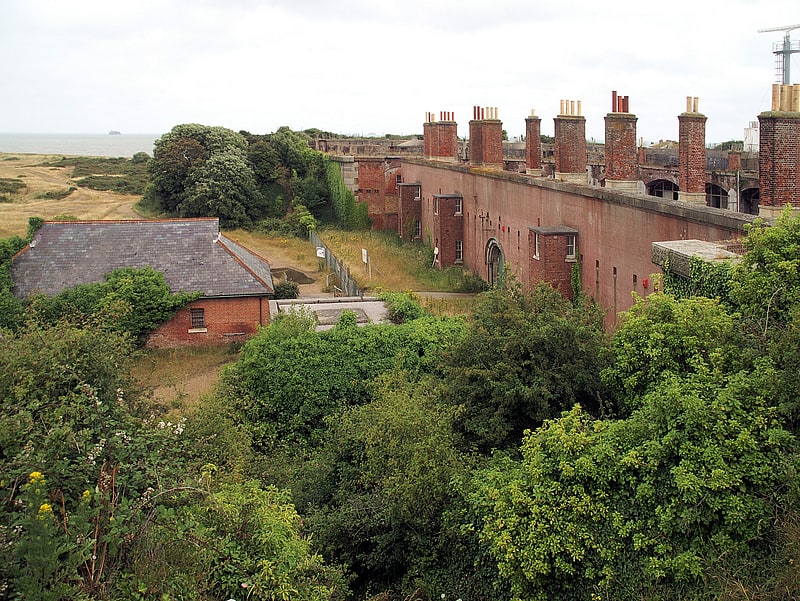
Fortress in Gosport, England. Fort Gilkicker is a historic Palmerston fort built at the eastern end of Stokes Bay, Gosport, Hampshire England to dominate the key anchorage of Spithead. It was erected between 1863 and 1871 as a semi-circular arc with 22 casemates, to be armed with five twelve-inch guns, seventeen ten-inch guns and five nine-inch guns. The actual installed armament rather differed from this. In 1902 the RML guns were replaced by two 9.2-inch and two six-inch BL guns, and before the First World War the walls were further strengthened with substantial earthwork embankments. The fort was disarmed in 1956 and used for storage until 1999, and is currently in a state of disrepair.[30]
Address: Fort Gilkicker, PO1 2 2 Gosport
HMNB Portsmouth
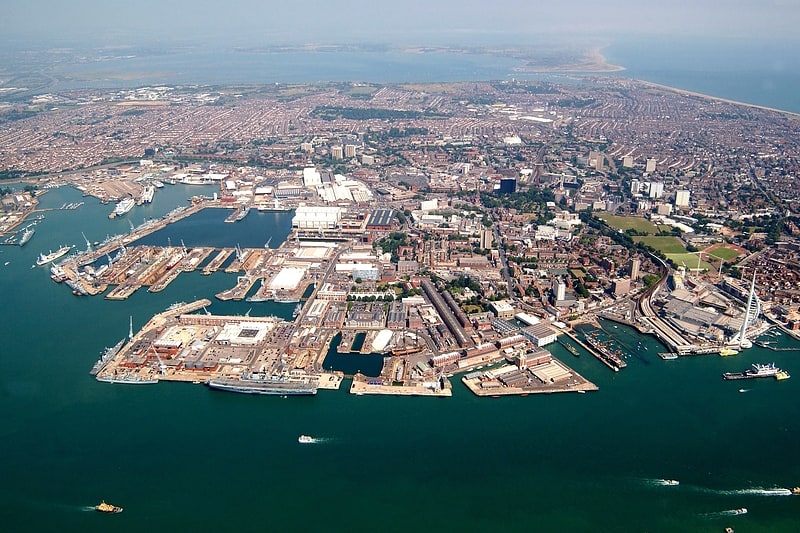
Building. Her Majesty's Naval Base, Portsmouth is one of three operating bases in the United Kingdom for the Royal Navy. Portsmouth Naval Base is part of the city of Portsmouth; it is located on the eastern shore of Portsmouth Harbour, north of the Solent and the Isle of Wight. Until the early 1970s, it was officially known as Portsmouth Royal Dockyard; thereafter the term 'Naval Base' gained currency, acknowledging a greater focus on personnel and support elements alongside the traditional emphasis on building, repairing and maintaining ships. In 1984 Portsmouth's Royal Dockyard function was downgraded and it was formally renamed the 'Fleet Maintenance and Repair Organisation'. The FMRO was privatized in 1998, and for a time, shipbuilding, in the form of block construction, returned. Around the year 2000, the designation HMS Nelson was extended to cover the entire base.
The base is the headquarters for two-thirds of the Royal Navy's surface fleet, and employs up to 17,200 people. The base is also home to a number of commercial shore activities (including a ship repair facility operated by BAE Systems Maritime); naval logistics, accommodation and messing; and personnel support functions (e.g. medical and dental; education; pastoral and welfare) provided by Defence Equipment and Support. Portsmouth has built sections for, and is the home port to, the two Royal Navy aircraft carriers, HMS Queen Elizabeth and HMS Prince of Wales. These ships required the harbour to be dredged to allow safe entry and exit. The project was intended to secure the base's future for the next forty years and would revitalise shipbuilding in the city; but, due to budget cuts in 2013 shipbuilding in Portsmouth was closed in favour of BAE keeping its yards in Glasgow open. It has been speculated this was to help retain Scotland in the union during the 2014 Scottish independence referendum and it has been suggested by the BAE chairman that shipbuilding could return to the city if Scotland voted for independence.
Portsmouth naval base is the oldest in the Royal Navy, and it has been an important part of the Senior Service's history and the defence of the British Isles for centuries. At one time it was the largest industrial site in the world. It is home to one of the oldest surviving drydocks in the world. The former Block Mills are of international significance, having been the first factory in the world to employ steam-powered machine tools for mass production. In 1985 a partnership between the Ministry of Defence and Portsmouth City Council created the Portsmouth Naval Base Property Trust to manage part of the historic south-west corner of the Naval Base, under a 99-year lease, as a heritage area: Portsmouth Historic Dockyard. It allows members of the public to visit important maritime attractions such as Mary Rose, HMS Victory and HMS Warrior.[31]
Fort Widley
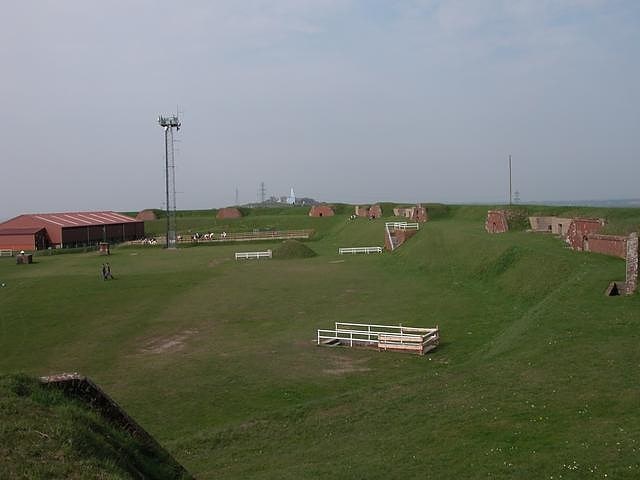
Equestrian facility in Portsmouth, England. Fort Widley is one of the forts built on top of Portsdown Hill between 1860 and 1868 on the recommendation of the Royal Commission on the Defence of the United Kingdom. It was designed, along with the other Palmerston Forts atop Portsdown, to protect Portsmouth from attack from the rear.[32]
Address: Fort Widley Portsdown Hill Road, PO6 3LS Portsmouth
Explosion! Museum of Naval Firepower
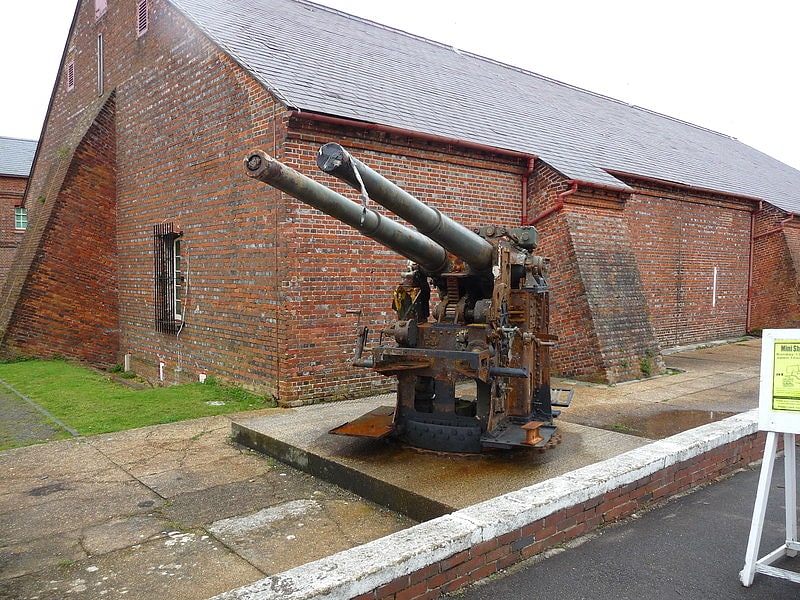
Museum in Gosport, England. Explosion! is the Museum of Naval Firepower situated in the former Royal Naval Armaments Depot at Priddy's Hard, in Gosport, Hampshire, England. It now forms part of the National Museum of the Royal Navy.
The museum includes a wide variety of exhibits ranging from the 18th century to the present day. These range in size from small arms, to missiles and missile launching systems, as well as complete gun turrets. Exhibits range from the Victorian RBL 20 pounder Armstrong gun through to the Second World War QF 4 inch Mk XVI naval gun. Post-war missile systems include the Exocet missile and launcher and Sea Dart missile. Modern weapons are represented in the Sea Wolf missile system and 4.5 inch Mark 8 naval gun.
The weapons cover all aspects of naval warfare from surface to surface, air to surface, surface to air and sub-surface weapons systems, including mines and torpedoes.
The museum has a waterside coffee shop which looks out on to the original 18th-century camber dock.[33]
Address: Priddys Hard, PO12 4LE Gosport
Portsmouth City Museum
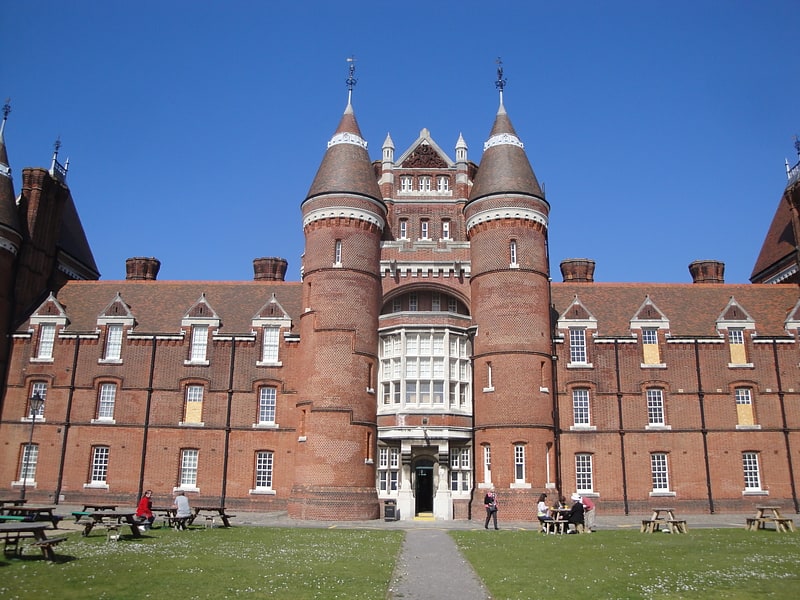
Museum in Portsmouth, England. Portsmouth Museum is a local museum in Museum Road in the city of Portsmouth, southern England. It is one of six museums run by Portsmouth Museums, part of Portsmouth City Council. The museum is housed in a Grade II listed building.[34]
Address: Museum Rd, PO1 2LJ Portsmouth
Milton Locks
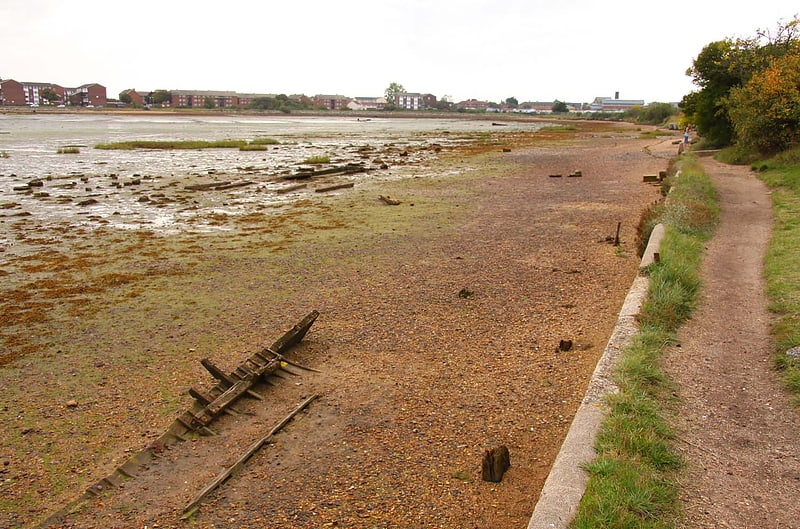
Milton Locks is a 1-hectare nature reserve in Milton in Hampshire. It is managed by the Hampshire and Isle of Wight Wildlife Trust.
This site on Portsea Island has grassland, a wood and a beach. There are saltmarsh plants such as sea purslane, sea aster and common saltmarsh-grass. The wood provides shelter for starlings and house sparrows.[35]